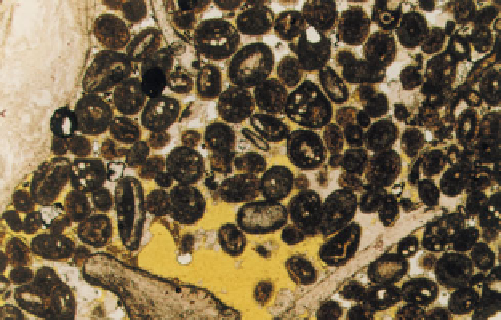Geoscience Reference
In-Depth Information
'Roach'. The latter is notable for the presence of cavities
formed from distinctive gastropod fossils (
55
).
'Purbeck Stone' (Upper Jurassic) is a hard shelly lime-
stone that takes a good polish and is mainly used for
decorative applications and paving. Figure
56
shows a
coarse-grained variety known as 'Purbeck Grub' and Figure
57
shows a finer-grained variety called 'Purbeck Cap'.
The Cretaceous System has yielded a number of
limestones that are important locally in southern
England. The Chalk (Upper Cretaceous Chalk) is a very
fine-grained, very pure, microporous limestone ranging
from white to grey in colour (
58
). Most chalk is soft and
weathers easily, but is sometimes used for building
interiors in southern England. Certain harder beds within
55
56
55
'Perryfield Roach' limestone (Dorset, England)
consisting chiefly of grain-supported ooliths (brown)
with minor shell, and with a high proportion of
macropores (10%, yellow). This view includes one of
the cavities that are characteristic of 'Roach', which
originated as empty moulds of fossils; PPT, ×35.
56
'Purbeck Grub' biosparite limestone (Dorset,
England) consisting of coarsely crystalline calcite
(sparite) and shell bioclasts, with a sparite cement;
XPT, ×35.
57
58
57
'Purbeck Cap' biomicrite limestone (Dorset,
England) consisting of sparry calcite shell bioclasts
(pink) with a matrix of microcrystalline calcite
(micrite, brown); XPT, ×35.
58
Close view of Chalk (Cambridgeshire, England)
showing its high microporosity. Sparse biomicrite
consisting of microcrystalline calcite (micrite) with
minor proportions of microfossils (mainly
foraminifera); UV, ×150.






